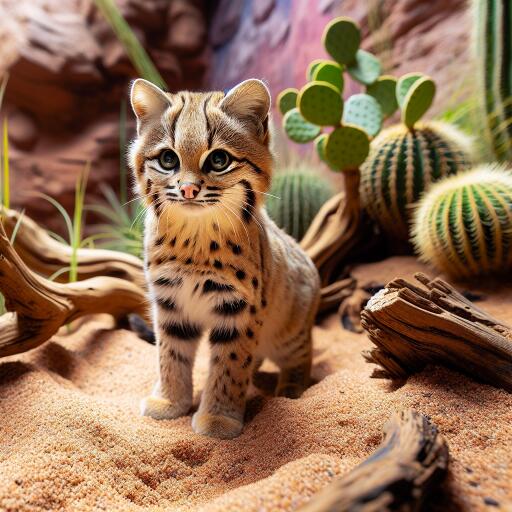
Tiny, Deadly Wild Cat Making a Comeback at The Living Desert Zoo
Among the ranks of the world’s felines, the black-footed cat may well be the most formidable hunter, pound for pound. This diminutive predator, seemingly similar in appearance to a domestic tabby, prowls the deserts and savannas of southern Africa with lethal efficiency. Each night, it can claim the lives of over ten birds or rodents, thereby playing a crucial role in controlling prey populations and removing carrion from its ecosystem.
Yet, despite its ecological importance and fierce prowess, the black-footed cat faces threats from habitat destruction, the illegal pet trade, climate change, and other anthropogenic pressures, leading to a worrying decline in its numbers in the wild.
At the forefront of efforts to reverse this trend is The Living Desert Zoo and Gardens located in Palm Desert. This accredited institution, renowned for its commitment to biodiversity and conservation, is undertaking significant strides to help preserve the species. Remarkably, it houses approximately 14 percent of all black-footed cats found within United States zoos, making it a beacon of hope for this species.
To bolster the black-footed cat’s dwindling populations, The Living Desert has been actively involved in a breeding program designed to enhance their numbers while ensuring genetic diversity is maintained. Nevertheless, breeding these elusive creatures and other desert carnivores like sand cats and fennec foxes presents unique challenges. According to Heather Down, The Living Desert’s animal care curator, these species are significantly underrepresented in zoological settings, and their breeding success rates have historically been low due to a limited understanding of their specific husbandry needs.
In response to these challenges, The Living Desert established the Desert Carnivore Conservation Center (DC3) in 2016. This innovative facility focuses on the specialized care and breeding of small desert carnivores, including the black-footed cat. It represents a concerted effort to improve the management and conservation of these vulnerable species through scientific research and collaboration.
One of the groundbreaking initiatives undertaken by the zoo involves the use of artificial insemination techniques. Down shared insights into a collaborative project that saw sperm collected from a male black-footed cat at the zoo’s Wildlife Hospital. This genetic material was then used to artificially inseminate a female black-footed cat, marking a pivotal step forward in the zoo’s breeding efforts. Previously, this pair had successfully bred naturally, and while they have faced challenges in reproducing since then, the zoo remains hopeful for a successful birth following this intervention.
The gestation period for black-footed cats is similar to that of domestic cats, about two months, leading to anticipation and hope for positive outcomes from these innovative breeding efforts. Through such endeavors, The Living Desert not only aims to increase the black-footed cat population but also to raise awareness about the critical need for conservation of desert ecosystems and the unique species they support.
Down emphasizes the importance of collaborative efforts and public education in the fight to conserve these habitats and their inhabitants. By shedding light on their conservation activities, The Living Desert hopes to inspire action and promote a greater understanding of the vital need for partnership and effective management in safeguarding small carnivore species for the enjoyment and education of future generations.





Leave a Reply